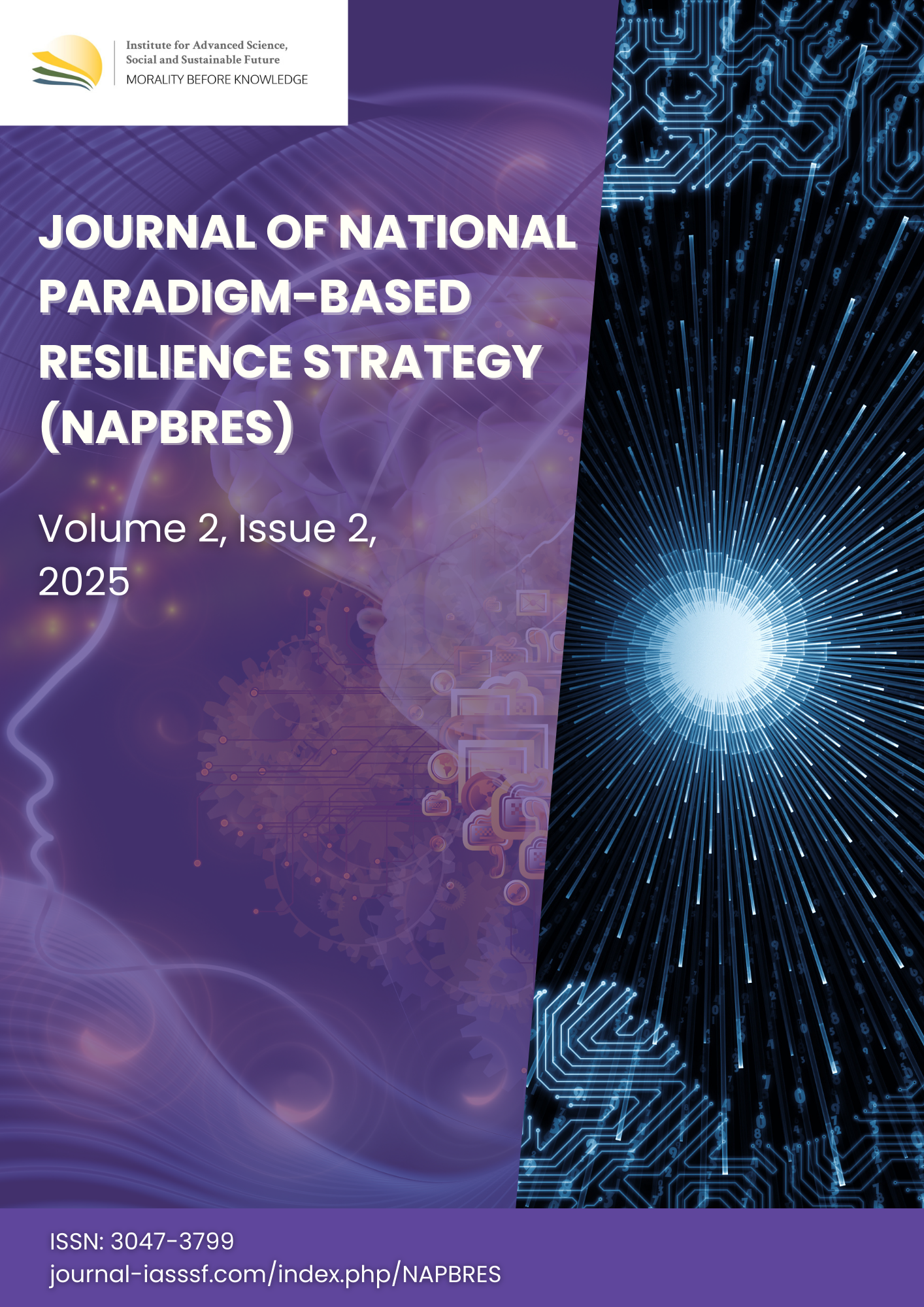The strategy of identity politics in the 2019 Indonesian presidential election in the era of the fourth industrial revolution
DOI:
https://doi.org/10.61511/napbres.v2i02.2025.2239Keywords:
strategy, presidential election, identity politics, millennials, social mediaAbstract
Background: Identity politics plays a crucial role in shaping electoral strategies, particularly among millennials who are highly active on social media. This study explores three approaches to identity politics—Primordialism (personal characteristics and political background), Constructivism (self-image and credibility), and Instrumentalism (campaign management)—to assess their influence on the chances of victory in the 2019 Indonesian presidential election. Methods: The research applied a quantitative design using questionnaires as the main instrument. Data were collected from 300 millennial respondents who were active social media users and voted in the 2019 election. Logistic regression and factor analysis were employed to analyze the effects of the three approaches on electoral success. Findings: The results reveal that self-image, credibility, and campaign management have a significant positive effect on winning chances, while political background shows a significant negative effect. Personal characteristics did not significantly influence victory. The combination of constructivist and instrumentalist strategies proved most effective, yielding a winning opportunity value of 0.92. Conversely, primordialist strategies based on ethnicity, religion, or political background reduced electoral prospects. Conclusion: Constructivist and instrumentalist approaches are the most effective identity politics strategies to appeal to millennials and social media voters. Meanwhile, reliance on primordialist factors weakens electoral chances. Effective campaign management combined with a strong candidate image and credibility provides the best formula for electoral success. Novelty/Originality of this article: This study highlights the unique electoral behavior of millennials in the digital era, showing that image construction, credibility, and campaign management outweigh traditional primordial factors. It contributes to understanding how identity politics evolves in the context of social media-driven elections in Indonesia.
References
Alsamydai, M. J. (2000). Political Marketing, Principle and Strategies Amman, Jordan. Dar Zehran for Publishing and distribution.
Alsamydai, M. J., & Al Khasawneh, M. H. (2013). Basic criteria for the success of the electoral candidates and their influence on voters' selection decision. Advances in Management and Applied Economics, 3(3), 105. https://ideas.repec.org/a/spt/admaec/v3y2013i3f3_3_7.html
Braca, A., & Dondio, P. (2023). Developing persuasive systems for marketing: The interplay of persuasion techniques, customer traits, and persuasive message design. Italian Journal of Marketing, 2023(2), 369–412. https://doi.org/10.1007/s43039-023-00077-0
Butler, S. (2024). Young people on social media in a globalized world: Self-optimization in highly competitive and achievement-oriented forms of life. Frontiers in Psychology, 15. https://doi.org/10.3389/fpsyg.2024.1340605
Cwalina, W., Falkowski, A., & Newman, B. I. (2017). Political marketing: Theory and practice. In C. Jansson-Boyd & M. Zawisza (Eds.), Routledge international handbook of consumer psychology (pp. 273–291). Routledge.
Danugroho, A. (2024). Defects of democracy: The continuity of identity politics in post-reform regional elections (Kecacatan demokrasi: Lestarinya politik identitas dalam pilkada pasca reformasi). Jurnal Sosiologi Dialektika, 19(1), 89–101. https://doi.org/10.20473/jsd.v19i12024.89-101
Djami, D. E., & Sembiring, S. (2023). An analysis of the influence of customer journey mapping in customer retention design on Shopee e-commerce using the service quality method. Jurnal TeIKa, 13(1). https://jurnal.unai.edu/index.php/teika/article/download/3088/2188/11063
Anwar, A. (2014). Politik Pencitraan-Pencitraan Politik. Graha Ilmu.
Chatzopoulou, E., & de Kiewiet, A. (2020). Millennials’ evaluation of corporate social responsibility: The wants and needs of the largest and most ethical generation. Journal of Consumer Behaviour, 20(3), 521–534. https://doi.org/10.1002/cb.1882
EACEA (Education, Audiovisual and Culture Executive Agency). (2012). Political participation and EU citizenship: Perceptions and behaviors of young people. Evidence from Eurobarometer surveys. European Commission
Firmanzah, P. D. (2007). Marketing politik: antara pemahaman dan realitas. Yayasan Pustaka Obor Indonesia.
Folkerts, J. (2006). The media in your life: An introduction to mass communication, 3/e. Pearson Education India.
Gagnier, C. M. (2008). Democracy 2.0: Millennial-generated change to American governance. Nat'l Civic Reveview, 97, 32. https://heinonline.org/HOL/LandingPage?handle=hein.journals/natmnr97&div=30&id=&page=
Gilman, H. R., & Stokes, E. (2014). The Civic And Political Participation of Millennials and Millennials Rising.@ Newamerica.
Hoegg, J., & Lewis, M. V. (2011). The impact of candidate appearance and advertising strategies on election results. Journal of Marketing Research, 48(5), 895-909. https://doi.org/10.1509/jmkr.48.5.895
Jacobson, J., Gruzd, A., & Hernández-García, Á. (2020). Social media marketing: Who is watching the watchers? Journal of Retailing and Consumer Services, 53, 101774. https://doi.org/10.1016/j.jretconser.2019.03.001
Kulachai, W., Lerdtomornsakul, U., & Homyamyen, P. (2023). Factors influencing voting decision: A comprehensive literature review. Social Sciences, 12(9), 469. https://doi.org/10.3390/socsci12090469
Kushartono, T. (2006). Perilaku Memilih di kabupaten Sukabumi (Studi Kasus Perilaku Pemilih pada Pemilihan Kepala Daerah Kabupaten Sukabumi secara Langsung Tahun 2005 di Kecamatan Pelabuhanratu, Cisaat dan Jampangkulaon Kabupaten Sukabumi. Universitas Gajak Mada.
Lievrouw, L., & Livingstone. (2006). Handbook of New Media: Updated Student. London; Sage Publ.
Luebke, S. M., & Engelmann, I. (2023). Perceiving politicians as true to themselves: Development and validation of the perceived political authenticity scale. PLOS ONE, 18(5), e0285344. https://doi.org/10.1371/journal.pone.0285344
Maharam, M. M., Marijan, K., & Nugroho, P. A. (2021). Ulama vs. a businessman, which one is more popular for raising electability in presidential elections? Utopía y Praxis Latinoamericana, 26(Esp.1), 237–247. https://doi.org/10.5281/zenodo.4556210
Newman, B. I. (1999). The mass marketing of politics: Democracy in an age of manufactured images. Sage Publications. Newman, B. I. (1999). The mass marketing of politics: Democracy in an age of manufactured images. Sage Publications.
Nimmo, D. (2006). Komunikasi Politik (Komunikator, Pesan, dan Media). Remadja Posdakarya
Rahayu, L., Sihombing, D. N., & Santoso, P. (2024). Indonesia’s non-military threats dynamics: A philosophical perspective. Jurnal Pertahanan: Media Informasi tentang Kajian dan Strategi Pertahanan yang Mengedepankan Identity, Nasionalism dan Integrity, 10(1), 39–53. https://jurnal.idu.ac.id/index.php/defensejournal
Rheingold, H. (1994). The Virtual Community Finding Connection in a Computerized World. Secker & Warburg
Schoenbach, K., De Ridder, J., & Lauf, E. (2001). Politicians on TV news: Getting attention in Dutch and German election campaigns. European Journal of Political Research, 39(4), 519-531. https://doi.org/10.1111/1475-6765.00586
Setiawan, W. (2017). Era Digital dan Tantangannya. Seminar Nasional Pendidikan 201
Teven, J. J. (2008). An examination of perceived credibility of the 2008 presidential candidates: Relationships with believability, likeability, and deceptiveness. Human Communication, 11(4), 391-408. https://citeseerx.ist.psu.edu/document?repid=rep1&type=pdf
Tomsa, D. (2020). Public Opinion Polling and Post-truth Politics in Indonesia. Contemporary Southeast Asia, 42(1), 1–27. https://www.jstor.org/stable/26937782
Vitak, J., Zube, P., Smock, A., Carr, C. T., Ellison, N., & Lampe, C. (2011). It's complicated: Facebook users' political participation in the 2008 election. CyberPsychology, behavior, and social networking, 14(3), 107-114. https://doi.org/10.1089/cyber.2009.0226
Downloads
Published
How to Cite
Issue
Section
Citation Check
License
Copyright (c) 2025 Riffal Ruchiandrean

This work is licensed under a Creative Commons Attribution 4.0 International License.












